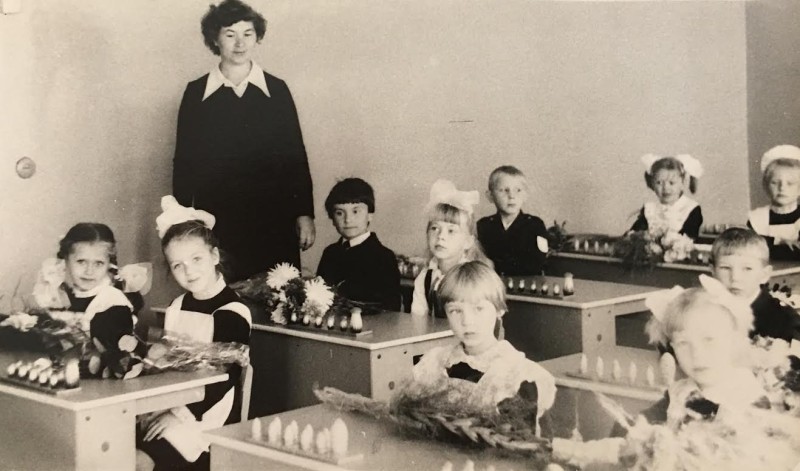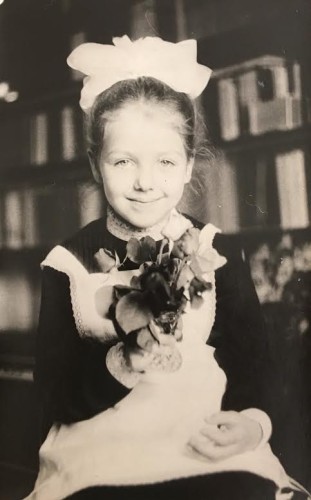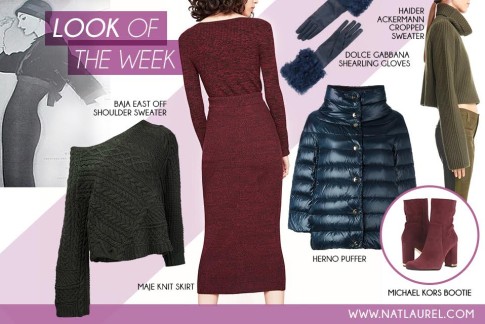Everything I needed to know about style I learnt from my Soviet school uniform.
 They say every therapist keeps solving his own most painful problem. This is certainly the case for me. As a style therapist I keep going back to the most pressing issues of my childhood and employing my strongest trait: attention to detail.
They say every therapist keeps solving his own most painful problem. This is certainly the case for me. As a style therapist I keep going back to the most pressing issues of my childhood and employing my strongest trait: attention to detail.
Here I am smiling at you with mischief all the way from the Orwell-ish 1984. The year I started my elementary school. I am wearing a uniform, like all the kids in the USSR did, elementary through high school. Girls had a brown wool dress with black apron. A white apron was worn for special occasions. Many of my Russian blog readers refer to this uniform as a highly traumatic experience because the colors were dull and the fabric was scratchy. The mere sight of a brown garment can provoke a PTSD response in many post-Soviet women. Our overwhelming appetite for fashion and style is partly rooted in the enforced wearing of this uniform.
I never found our school uniform hideous. It didn’t prevent us from wearing other stylish garments. The style agenda in the USSR felt very much Berkeley-feminist inspired anyway. I took the uniform as a given and concentrated on things I seemed to have control over: the finishes and details. The uniforms came with different skirt styles: pleated, A-line, or full circle. Our moms hemmed them for us to their liking. They could be reasonable mid-knees or a playful skater frock with pleats. Necklines varied too, either stand-up notch collar, pointed or a rounded Peter Pan, lace or cotton.
The collars and cuffs were detachable and it was our responsibility to separate and hand-wash them and then sew them back onto our uniform. Sunday evening usually meant last minute ironing and putting our lace trimmings back. Showing up in school without them meant serious lace trimming shaming; it was out of question. By the age of seven I was a natural at hand washing, ironing, and sewing the lace on my dress. Today, hand-washing silk dresses and tops is a special form of meditation for me.
I had a very distinct idea of what I wanted my uniform to be: a sharply pleated short skirt, well above the knee, skater style, a Peter Pan lace collar and an apron with perky, lavish flounce. The whimsical mini balanced out the austerity of the fabric and colors used. The frills and Peter Pan collar sinusoid lines complemented my face. I knew nothing about all that at the time, it was purely intuitive. Only I never had my uniform styled like that.
 What I wore elementary through middle school was a shapeless A-line with a stand-up notch collar. My apron was minimalistic and frill-free as they would say these days. I can’t tell you enough how much it made me suffer. A boy I was desperately in love with was desperately in love with the girl from another grade whose uniform was styled very much like what I just described. It enhanced her natural beauty and she truly was the prettiest girl in school. I always felt like an ugly duckling in my frill-free apron. My dad had a lot to do with this minimalistic-utilitarian approach to my school uniform. He actually had impeccable taste and could make a great stylist. But he was really into a gamine and tomboy style, which felt edgy in the 1980s. But most importantly, it looked great on my mom. So it was used as a default style on me. As for my mom…., well, she was busy and tried to prioritize. No one noticed my features needed different styling. It was not a priority.
What I wore elementary through middle school was a shapeless A-line with a stand-up notch collar. My apron was minimalistic and frill-free as they would say these days. I can’t tell you enough how much it made me suffer. A boy I was desperately in love with was desperately in love with the girl from another grade whose uniform was styled very much like what I just described. It enhanced her natural beauty and she truly was the prettiest girl in school. I always felt like an ugly duckling in my frill-free apron. My dad had a lot to do with this minimalistic-utilitarian approach to my school uniform. He actually had impeccable taste and could make a great stylist. But he was really into a gamine and tomboy style, which felt edgy in the 1980s. But most importantly, it looked great on my mom. So it was used as a default style on me. As for my mom…., well, she was busy and tried to prioritize. No one noticed my features needed different styling. It was not a priority.
By the time I entered high school, the USSR had collapsed, the uniform was abolished and we could express ourselves any way we pleased. We were indulging in dressing Kurt Cobain style and wearing Metallica concert t-shirts. But when our graduation parties came around, we wanted our uniforms. By 2000 it had become retro to wear a Soviet uniform for graduation. Local newspapers were filled with ads “looking for an old uniform size 4 to rent.” But in 1995 all things Soviet were still considered degrading and offensive. It took us a lot of courage to walk down the street outfitted in the Soviet uniform. My uniform was exactly the way I always wanted it: the apron had oversized perky flounce, the neckline was Peter Pan with an elaborate lace on it, and the skirt was full. This was one of my first mature statements of style and beyond.
Decades later I became an image consultant. I help women see how little things can make or break the look, even on such seemingly static thing as a uniform it matters. But my most important mission is to help all S-type beauty women trapped in the mainstream-imposed tomboy style find their way to their natural, feminine beauty.


→ Prev
Next →